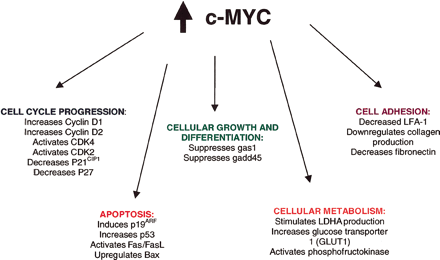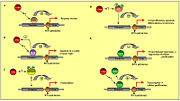PMID:9680483</ref>' scene='Insert optional scene name here' />
The c-myc gene is consisted of three exons located on human chromosomes 8q24. The c-Myc sequence contains many Myc boxes, or conserved N-terminal domains, which are found in N-Myc and L-Myc.[3] The C-terminal region of c-Myc contains the helix-loop-helix, leucine zipper, and a basic region. These three components dimerize to form a bHLH LZ motif. The binding of DNA is achieved by the combination of the bHLH LZ motif and another bHLH LZ protein, Max.DNA-bound Myc-Max complexes activate transcription through the amino terminal 143 amino acids of c-Myc, known as the transcriptional activation domain (TAD). [4]
Molecular Functions
Once the Myc-Max complex binds to the specific DNA hexanucleotide core sequence, called the E boxes, the transcriptional activation domain then permits interaction with specific elements of the transcriptional machinery to allow transcription of nearby growth-related genes. c-Myc can also function as a transcriptional repressor of growth-inhibiting genes, not just an activator. [5]
Expression of c-myc in the normal cell is regulated by external signals. [5] High levels of m-Myc activity might lead to proliferation and inhibition of differentiation while diminished levels of c-Myc activity lead to loss of proliferative capacity and to terminal differentiation. The c-Myc protein is involved in cellular transformation and mitogenesis, but is also a potent inducer of programmed cell death, or apoptosis.[6] C-Myc protein is also the expression of c-myc gene for normal embryonic development.

Cancer Development
The c-Myc protein or the c-myc gene is overexpressed in a wide variety of human cancers with 80% of breast cancers, 70% of colon cancer, 90% of gynecological cancers, 50% of hepatocellular carcinomas and a variety of hematological tumors possessing abnormal myc expression.[4]
The genesis of lymphoid malignancies is caused by translocations that juxtapose the c-myc proto-oncogene at chromosome 8q24 to one of three immunoglobulin genes on chromosome 2, 14, or 22 in B cells activate the c-myc gene. The c-myc gene is a central oncogenic switch for oncogenes and the tumor suppressor APC. The APC tumor suppressor protein mediates the degradation of β-catenin. The Wnt oncoprotein is shown activating its receptor, which results in the stabilization of free β-catenin. β-Catenin, which sustains activating mutations in human cancers, is a cofactor for the transcription factor Tcf. Tcf activates c-myc expression through specific DNA binding sites. [3] In addition to activation of the c-myc gene through deregulated expression, point mutations in the coding sequence have been found in translocated alleles of c-myc in Burkitt’s lymphomas. [7]
References
- ↑ http://www.uniprot.org/uniprot/P01106#section_ref
- ↑ http://www.abcam.com/c-Myc-protein-Human-ab84132.html
- ↑ 3.0 3.1 Dang CV. c-Myc target genes involved in cell growth, apoptosis, and metabolism. Mol Cell Biol. 1999 Jan;19(1):1-11. PMID:9858526
- ↑ 4.0 4.1 Gardner, L, L Lee, and C Dang. "The C-Myc Transcription Factor." Encyclopedia of Cancer (2002): N. pag. Web. <http://myc-cancer-gene.org/documents/MycReview.pdf>.
- ↑ 5.0 5.1 Amati B, Littlewood TD, Evan GI, Land H. The c-Myc protein induces cell cycle progression and apoptosis through dimerization with Max. EMBO J. 1993 Dec 15;12(13):5083-7. PMID:8262051
- ↑ Kato GJ, Dang CV. Function of the c-Myc oncoprotein. FASEB J. 1992 Sep;6(12):3065-72. PMID:1521738
- ↑ Yano T, Sander CA, Clark HM, Dolezal MV, Jaffe ES, Raffeld M. Clustered mutations in the second exon of the MYC gene in sporadic Burkitt's lymphoma. Oncogene. 1993 Oct;8(10):2741-8. PMID:8397370


